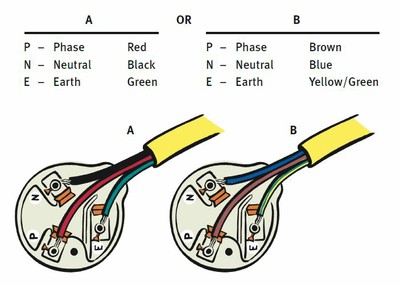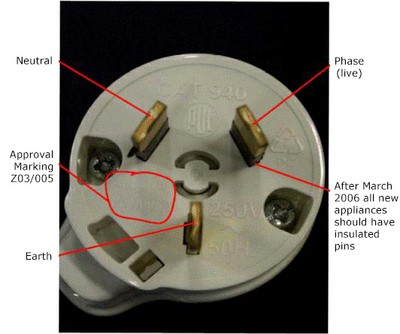Cords, plugs, multi-boxes, and associated safety equipment like residual current devices (RCDs) all need to be in good condition to prevent fires and electric shocks.
Cords – including extension cords – are prone to fraying or suffering loose connections over time. Plugs and outlets like multi-boards need to be carefully wired and maintained to ensure both a good supply of electricity and limit the potential for shocks or fires. We have produced guidance on safely using cords, extension cords, multi-boards and plugs, as well as information about safety devices like RCDs and isolating transformers.
Cords
Always ensure the cable is unplugged before checking for damage.
- Make sure cords are in good condition. Frayed, cracked or damaged cords are dangerous and may result in fire or cause an electric shock.
- Make sure the outer sheath is not damages by cuts, cracking or fraying.
- Check there are no internal wires which are exposed or twisted, and there are no signs of overheating or burning on plugs (and on sockets of an extension cord).
- Any cables which have been 'repaired' using tape should not be used. Check the cable entry and anchor points into plugs, sockets, or equipment are secure and no internal coloured insulation of the wires is exposed.
- Extension cords are intended for temporary use only. If a permanent power source is required where an extension lead is in use, ask a licenced electrician to install a power socket.
- If an extension lead is being used outside, always use an RCD or isolating transformer to protect you from a fatal electric shock if the cord becomes damaged while you are using it.
Always unplug cords when not in use. It is a good idea to connect the plug and socket of extension cords together when they are not being used to prevent the pins from getting damaged.
Cord safety checklist
- Are all electric cords in good condition, with no cracking or fraying in the outer cover or any internal wires exposed?
- Are all electric cords clear of rugs and furniture?
- Are all cords out of the way so they can’t be tripped over, damaged by furniture, or caught in any way?
Multi-boxes
Electrical Portable Outlet Devices (EPODs) commonly known as 'PowerBoards', 'Multi-Plugs' and 'Multi-Boxes' are multiple electrical sockets mounted onto a portable case. This allows you to plug in several appliances at once.
Check the maximum load and be careful not to exceed it.
- Multi-boxes are ideal for supplying electricity to appliances that consume minimal power, such as computers and TVs.
- They should not be used with appliances that draw a heavy load of electricity such as heaters, electric jugs, washing machines and stoves. These appliances should be plugged directly into a wall socket.
Multi-boxes are often used in older houses where sometimes there is only a single socket-outlet in a room. They are also used to accommodate the growing number of electrical appliances in households, even in new houses.
Using multi-boxes safely
The way most multi-boxes are used is that they are plugged into a free wall socket-outlet and the connected board containing typically four to eight socket-outlets should be fixed adjacent to that socket-outlet.
This portability leaves the multi-box open to risk of physical damage, in that they can be easily dropped, stood upon, and caught under furniture. This damage is not always apparent and is often not noticed. The result of this damage often results in poor electrical contact between plug pins of appliances connected and the multi-box. Check regularly for wear and tear, and if the multi-box is damaged, stop using it and replace it.
Poor electrical contact and overloading is a major cause of electrical fires, especially if the appliances connected draws heavy current loads, such as:
- heaters
- electric jugs/kettles
- washing machines
- stoves,
These types of appliance should be plugged directly into wall socket-outlets, not multi-boxes, because if used together they could exceed the 'Total load' rating of the multi-box.
- Never use them in damp or wet areas if marked 'For indoor use only'.
- Always place multi-boxes out of the reach of young children.
Additional multi-box safety features
- Some multi-boxes have additional features such as:
- Shuttered socket-outlets, which prevent children pushing something into them.
- Built-in RCD that will automatically disconnect power in the event of an earth fault.
- Surge protector that prevents sensitive electronic equipment being damaged by electrical surges.
Sockets and switches safety checklist
- Are all sockets, switches and multiboxes working properly with no damaged or broken plugs, sockets, light switches or light fittings?
- Are all sockets and switches cool to the touch?
- Do all electric plugs fit snugly into the sockets?
- Are all multi-boxes placed up high, out of the reach of children?
- Have you installed safety devices such as RCDs, shuttered sockets and recessed outlets?
- Have you limited the number of appliances plugged into one outlet, so as not to draw too heavy a load on the circuit?
- Do you have only one heater per outlet?
Cord and outlet safety devices
When buying electrical fittings and appliances, always ask for products that have an enhanced level of safety, such as a built-in RCD or recessed sockets.
Residual current devices
An RCD constantly monitors the current flowing along a circuit. If it senses any loss of current, where electricity is diverting to the ground rather than through the circuit, is will immediately shut off.
If your body is providing the path for the electricity to divert to the ground, you could be seriously injured, burned, severely shocked or electrocuted.
- An RCD will prevent the shock being fatal by shutting the system down instantly.
- RCDs should be installed in damp areas of your home where there are electric fittings, such as bathrooms, laundries, kitchens, garages, pools and external electric outlets.
Different types of RCDs include fixed RCDs, which can be installed in standard socket outlets and wired in a way that protects other outlets downstream, circuit RCDs, which are wired into your switchboard, and portable RCDs.
It is a legal requirement for all new circuits originating at the switchboard and supplying lighting or socket outlets (power points) in domestic buildings to have RCD protection. These RCDs will normally be located at the switchboard. They will provide protection for all electrical wiring and appliances plugged into new circuits.
Testing your RCD
You can test your socket outlet and portable RCDs by plugging in a small electrical appliance (such as a night-light):
- Press the 'test' button.
- If the appliance turns off, the RCD is working.
- Make sure you press 'reset' once the test is complete.
- You should test these RCDs regularly (eg every three months).
It’s a good idea to test switchboard RCDs every six months by checking that it trips when the 'test' button in pushed. However, be aware that tripping circuits will turn off the power to any appliances on that circuit. So appliances with electronic clocks will have to be reset. For this reason, it’s a good idea to test your switchboard RCDs when changing to and from daylight saving – when clocks will have to be reset anyway and it will be about six months since the RCDs where last tested.
If your RCD trips at other times; note the appliances connected at the time, unplug all connected appliances and reset the RCD, plug in the appliances one at a time and switch on. If the RCD trips when an appliance is switched on, the appliance should be repaired or replaced. If the RCD does not trip when appliances are plugged in and switched on, one at a time, but trips when several appliances are used together, you should get your RCD checked by a licensed electrician.
Residual current devices safety checklist
- Do you have RCDs installed in the damp areas of your home where you have electrical outlets – such as the bathroom and laundry?
- Do you test your RCDs regularly, and are they working correctly?
- Do you use an RCD or an isolating transformer with all electrical equipment outside?
Isolating transformers
An isolating transformer protects you from an electric shock by providing an electricity supply that is isolated from earth. For maximum protection, the transformer should be placed as near as possible to the electrical outlet.
Shuttered sockets
Socket outlets fitted with internal protective shutters make it more difficult for children to poke things into them.
Recessed sockets and shrouded plugs
Recessed sockets and shrouded plugs on electrical fittings, extension cords and double adaptors help to prevent contact with the metal pins on a plug if they become partially exposed.
Insulated metal pins
An additional safety feature is a plastic insulation sleeve on the metal pins on a plug. Like recessed sockets, these prevent contact with the metal pins while connected to electricity supply.
The pins of insulated pin plugs should be inspected for damage to the insulation of the pins, and, if fitted, the shroud on cord extension sockets.
Transparent sockets and plugs
Clear-backed sockets and plugs expose any problems with the wiring.
Four-way switched socket outlets
These can be installed as part of your home’s permanent fittings to give you four sockets at an outlet, eliminating the need for multi-boxes and extension cords.
How to wire a plug
We recommend that you use appliances fitted with moulded plugs that do not need rewiring. However if you do need to rewire, there is only one way to wire an electrical plug safely.
Study the diagram below and ensure that you always connect the correct colour to the correct letter. In New Zealand, it is most common for the coloured wires inside power cords to look like either A or B. They should be connected as illustrated below.

Warning! If you are rewiring a plug yourself, always ensure the wires are correctly positioned, as this is a common cause of serious electric shocks if wired incorrectly.
All household power outlets in New Zealand only use a flat three or two-pin plug, depending on whether an earth connection is fitted.
Typical three pin plug:

Last updated